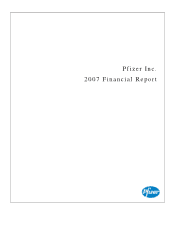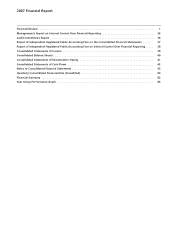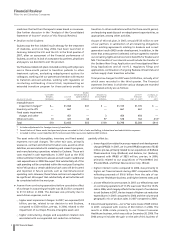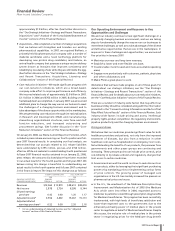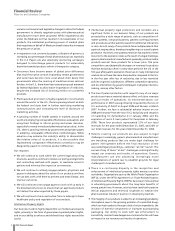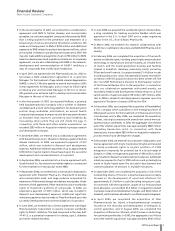Pfizer 2007 Annual Report Download - page 9
Download and view the complete annual report
Please find page 9 of the 2007 Pfizer annual report below. You can navigate through the pages in the report by either clicking on the pages listed below, or by using the keyword search tool below to find specific information within the annual report.
•The large number of patients within our various therapeutic
categories that are untreated. For example, of the tens of
millions of Americans who need medical therapy for high
cholesterol, we estimate only about one-fourth are actually
receiving treatment.
•Refocusing the debate on health policy to address the cost of
disease that remains untreated and the benefits of investing
in prevention and wellness to not only improve health, but save
money.
•Developing medicines that meet medical need and that patients
will take; that physicians will prescribe; that customers will
pay for; and that add the most value for Pfizer.
•Stepping up our focus and investments in emerging markets by
developing strategies in areas, especially Eastern Europe and
Asia, where changing demographics and economics will drive
growing demand for high-quality healthcare and offer the
best potential for our products.
•Worldwide emphasis on the need to find solutions to difficult
problems in healthcare systems.
Our Cost-Reduction Initiatives
During 2007, 2006 and 2005, we made significant progress with our
cost-reduction initiatives, which were designed to increase efficiency
and streamline decision-making across the company. These initiatives
were launched in early 2005 and broadened in October 2006.
On January 22, 2007, we announced additional plans to change
the way we run our business to meet the challenges of a changing
business environment and take advantage of the diverse
opportunities in the marketplace. We are generating net cost
reductions through site rationalization in R&D and manufacturing,
streamlining organizational structures, sales force and staff
function reductions, and increased outsourcing and procurement
savings. Our cost-reduction initiatives will result in the elimination
of about 10,000 positions, or about 10% of our total worldwide
workforce by the end of 2008. These and other actions will allow
us to reduce costs in support services and facilities, and to redeploy
a portion of the hundreds of millions of dollars saved into the
discovery and development work of our scientists. These and
other initiatives are discussed below.
Net of various cost increases and investments during 2007, we
achieved, on a constant currency basis (the actual foreign
exchange rates in effect in 2006), a reduction of about $560
million in the Selling, informational and administrative expenses
(SI&A) pre-tax component of Adjusted income compared to 2006.
By the end of 2008, we expect to achieve a net reduction of the
pre-tax total expense component of Adjusted income of at least
$1.5 billion to $2.0 billion, compared to 2006 on a constant
currency basis (the actual foreign exchange rates in effect in
2006). (For an understanding of Adjusted income, see the
“Adjusted Income” section of this Financial Review.)
Projects in various stages of implementation include:
Pfizer Global Research and Development (PGRD)—
•Creating a More Agile and Productive Organization—To increase
efficiency and effectiveness in bringing new therapies to patients-
in-need, in January 2007, PGRD announced a number of actions
to transform the research division. Many of the actions have
been completed. We have exited two discovery therapeutic areas
(Gastrointestinal & Hepatology and Dermatology), though we
continue to develop compounds in those areas that are already
in the pipeline. We have consolidated each research therapeutic
area into a single site. In addition, of six sites that were identified
for closure, two (Mumbai, India and Plymouth Township,
Michigan) have been closed. Operations have been scaled back
significantly in the other four sites (Ann Arbor and Kalamazoo,
Michigan; Nagoya, Japan; and Amboise, France). The timing of
final closure of the remaining sites is subject to business needs and,
in the case of Nagoya and Amboise, to consultation with works
councils and local labor law. As of December 31, 2007, all portfolio
project transfers were completed with minimal progress
development interruption and are now in their new sites. This
reorganization has resulted in smaller, more agile research units
designed to drive the growth of our bigger pipeline, while
maintaining costs, and generating more products.
•Standardization of Practices—Standardization of practices
across PGRD is driving costs down and increasing efficiencies in
our research facilities, resulting in significant savings. Centers
of emphasis have been built to take advantage of special skill
sets, reduce waste and enhance asset utilization. We
substantially reduced the number of pilot plants that
manufacture the active ingredients for our clinical supplies,
making more efficient use of the capacity retained. Clinical
supply depots across the globe are being realigned with future
needs. For example, across Europe and Canada 26 out of 37
depots have been identified for rationalization, with 24 closures
completed through December 31, 2007.
•Enhanced Clinical Trial Design—To reduce the frequency and cost
of clinical trial failures, a common problem across the industry,
a key objective for PGRD has been to improve our clinical trial
design process. For this reason, PGRD has standardized and
broadly applied advanced improvements in quantitative
techniques. For example, pharmacokinetic/pharmacodynamic
modeling and computer-based clinical trial simulation, along with
use of leading-edge statistical techniques, including adaptive
learning and confirming approaches, are being used and we have
begun to transform the way clinical trials are designed. Benefits
achieved to date from this initiative include improvements in
positive predictive capacity, efficiency, risk management and
knowledge management. Once fully implemented, this
Enhanced Clinical Trial Design initiative is expected to yield
significant savings and enhance research productivity.
Two new molecular entities and multiple new indication programs
for in-line products advanced into Phase 3 development during
2007. We expect a significant number of new molecular entities
and new indication programs to advance to Phase 3 by the end
of 2009. We intend to increase resources dedicated to
biotherapeutics, with the objectives of launching one product per
year within 10 years, strengthening our antibody platform and
building our vaccine business. In addition, we will enhance our
capability to identify the right targets and pathways by harnessing
new biologic techniques to allow identification and the pursuit
of the most relevant pathways. We expect to fund a number of
2007 Financial Report 7
Financial Review
Pfizer Inc and Subsidiary Companies

